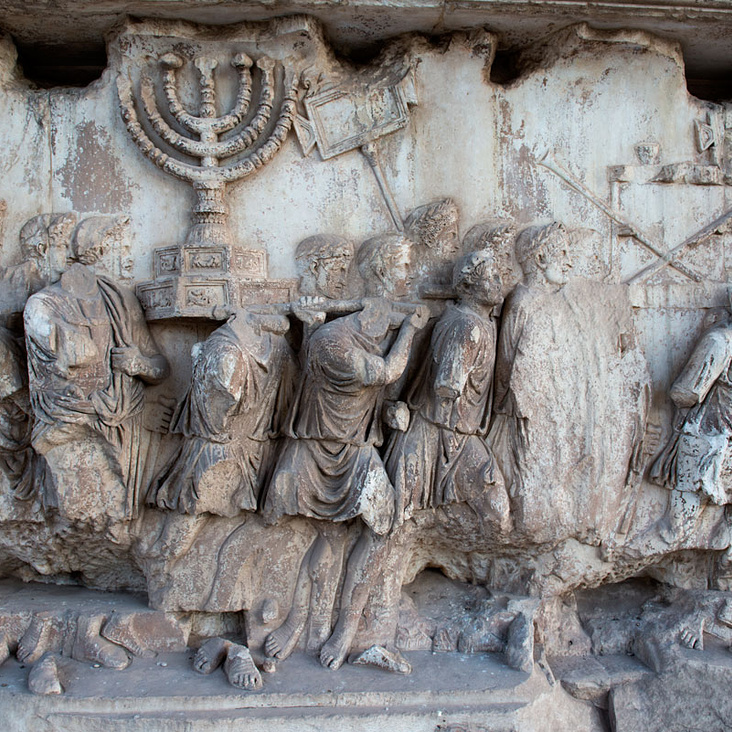Laura Arnold Leibman delivered a three-part lecture series entitled “The Art of the Jewish Family: Material Culture in Early New York.” Lecture 1, “Pieces of Silver” took place on Wednesday, March 14, 2018. Ellen Smith, Associate Professor and Director of the Hornstein Jewish Professional Leadership Program, Brandeis University, offered a response.
Wednesday, March 14, Lecture 1: Pieces of Silver
Wednesday, March 28, Lecture 2: Portrait in Ivory
Thursday, April 12, Lecture 3: Commonplace Things
Additional support provided by The David Berg Foundation.
Between 1750 and 1850, New York went from being one of many small Jewish communities on the Atlantic seaboard to the largest Jewish community in the Americas, a community whose size rivaled or surpassed many of the historic Western European Jewish centers. The population surge was only one part of the story: over the course of the century, the community shifted from Sephardic- to Ashkenazi-centered, and family structure metamorphosed as Jews adapted their marriage patterns to American life. The Art of the Jewish Family looks at how Jews of early New York mediated the radical changes in their lives through material culture, particularly objects associated with displaying and maintaining the family. In each lecture Leibman will focus on one of three key items typically found in Jewish homes: silver, portraits, and commonplace books.
Our story begins just before the Revolutionary War. While the rise of the Enlightenment had caused Christian marriages to shift from arranged marriages as a social ideal to partnerships in which women were encouraged to marry for love, early Jewish American marriage contracts remained deeply tied to economics and social relations throughout the eighteenth century. Jewish marriages tended to be more conservative because in the Atlantic World, women mattered deeply to kinship and Jewish culture. The gifts women received upon marriage helped cement families and reminded women of their obligations to both their biological and conjugal relations. By the early nineteenth-century, however, this ideal had fallen into question. While women still found themselves weighed down by economic calculations, marriage increasingly took on romantic expectations. Intimate portraits began to be exchanged as love tokens prior to engagement. By the 1830s, Jewish women embraced the romantic ideal of marriage more fully, often choosing not to marry rather than be yoked to a loveless, but economically advantageous, partnership. Just as Christian women had used the language of romance to challenge the older notion of arranged marriages, so too single Jewish women now co-opted the language of romance and affection to challenge traditional notions of Jewish kinship. This reformulation of Jewish kinship had important, long-term ramifications for Jewish communal life as women’s role expanded beyond creating biological Jews (offspring) to cementing the larger Jewish nation via affective ties. Commonplace books and personal letters became a key place where Jewish women reformulated the ideal of the Jewish family.
This opening lecture examines the role of silver in an arranged marriage just prior to the Revolutionary War. After seventeen-year-old Reyna Levy (1753–1824) married her first cousin Isaac Moses in 1770, she received six silver beakers from her uncle, silversmith Myer Myers. Now housed at the Metropolitan Museum of Art, the beakers became an important heirloom for the family, winding their way through the generations, tying the bloodlines of the dynasties together, linking Levy to Moses, Myers to Levy, and Levy to Myers. Like the beakers, the marriage was driven by silver. Not only was Reyna’s dowry extraordinarily large, the insular marriage was dictated by the business needs of the men around her and the connections it forged. Leibman will use the beakers to tell Reyna’s life story and to explain the family roles Jewish women in New York were expected to play in the 1770s–1790s.
Laura Arnold Leibman is Professor of English and Humanities at Reed College in Portland, Oregon. Her work focuses on religion and the daily lives of women and children in early America, and uses everyday objects to help bring their stories back to life. She is the author of Indian Converts (UMass Press, 2008), the co-editor of Jews in the Americas, 1776–1826 (Routledge, 2017), and the author of Messianism, Secrecy and Mysticism: A New Interpretation of Early American Jewish Life (Vallentine Mitchell, 2012), which won a National Jewish Book Award, a Jordan Schnitzer Book Award from the Association for Jewish Studies, and was selected as one of Choice’s Outstanding Academic Titles for 2013. Leibman has previously been a visiting scholar at Oxford University, Utrecht University, and the University of Panama. Known for her scholarship in Digital Humanities, she served as the Academic Director for the award-winning multimedia public television series American Passages: A Literary Survey (2003). Leibman, who earned her PhD from UCLA, is currently at work on a book that uses material culture to trace the history of members of a multiracial family who began their lives as slaves in the Caribbean and became some of the wealthiest Jews in New York. She has been appointed Leon Levy Foundation Professor of Jewish Material Culture at Bard Graduate Center for the spring 2018 semester.












